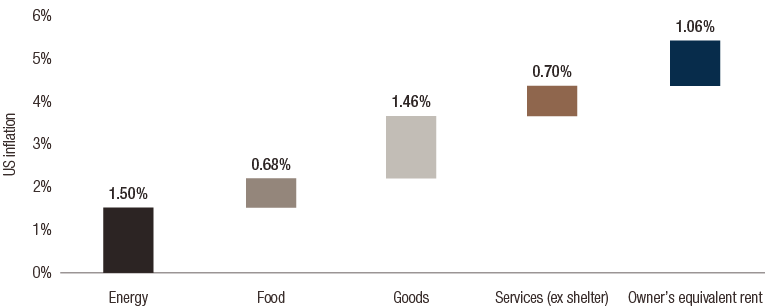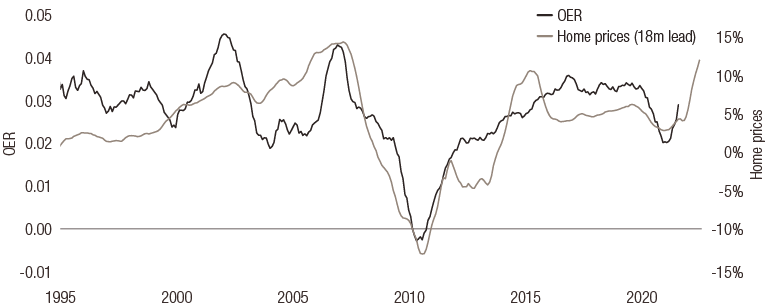global perspectives
Simply put: energy inflation is transitory, unlike shelter costs



In our latest multi-asset macro update, we share the following views:
- The recent US inflation report highlights several key contributors to rising inflation, not just energy.
- The cost of shelter has risen and is likely to continue to drive inflation over the medium term, reflecting the rapid rise in house prices and the lagging impact this can have on inflation measures.
- Both the Federal Reserve and investors will need to pay close attention to this factor in the months ahead.
Markets and central banks have been discussing the supposedly ‘transitory’ nature of inflation. The factors being heavily scrutinised include energy prices, supply-chain bottlenecks and labour-supply shortages (notably in the US). Most of these factors have impacts that are lagging and vary in size and duration, which combine into a temporary elevation of inflation that is pushing central bankers out of their comfort zone.
The latest US monthly inflation report is no exception and once more confirms the importance of the inflation theme to market activity. We think the key takeaway from this report is that energy inflation is less likely to surprise on the upside than ‘service’ inflation – an inflation source that is slow to take effect yet is strongly tied to the good economic conditions we are experiencing today.
US headline inflation reached 5.4% in September and its core reading rose to 4%. In our view, there are three factors behind this:
- Energy continues to be the largest contributor to inflation, adding 1.5% year-on-year. This shouldn’t be surprising given oil prices have risen by around 100% year-on-year. Such base effects have material consequences on inflation numbers, but oil prices would need to reach $160 per barrel over the next 12 months to maintain this high level of contribution.
- Food and goods inflation added around 2% to inflation. Over the longer run, food inflation should evolve around 2% while goods inflation will be roughly zero, meaning this should also be a source of temporary headline inflation.
- The final element – service inflation – is our key focus here. This has contributed roughly 1.7% to inflation, two thirds of which has been the outcome of an element which is technically not even a service: the cost of shelter. The cost of shelter has risen 3.2% year-on-year and represents a 30% weight in the inflation basket.
FIG. 1. Year-on-year US Inflation Decomposition

Source: Bloomberg, LOIM at October 2021. For illustrative purposes only.
Within the “shelter” component, one particular element has a sizeable weight on its own: the owner’s equivalent rent of primary residence (OER). The OER’s weight in the headline CPI is 23.6%, accounts for 29.9% in the core CPI, and in the personal consumption expenditure (PCE) basket, its weight stands at 11.4% for headline and 12.9% for core. The OER therefore considerably affects the evolution of prices and monetary policy. In our eyes, this component needs to be monitored closely to anticipate the evolution of inflation.
In order to understand how this number might evolve, understanding how it is calculated is crucial. The Bureau of Labor Statistics (BLS) measures the OER using a survey, where primary residence owners are asked how much rent they think they would be charged if they were to rent their home instead of owning it. This component is therefore derived from the perceived value of property owners’ homes and multiple factors can affect it.
Research from the Federal Reserve (Fed) Bank of Cleveland finds that the strongest driver of OER inflation is lagged house-price appreciation – if owners perceive their house prices have risen, then their answer to the survey is likely to increase. So what are house prices doing right now? The US Case-Shiller index is currently showing a 20% year-on-year increase in house prices, a growth rate that has not been seen during the 1988-2021 period. As illustrated in figure 2, the historical relationship between house prices and OER increases highlights two key elements:
- Firstly, their relationship tends to lag by 18-months – it takes a long time for OER inflation to materialise and then remains on a rising trajectory for a long time.
- Secondly, having already seen a significant rise in house prices, a linear regression forecasts the OER to grow at a 4.5% rate in 18 months’ time.
This projection should yield an inflation contribution of 1.3% to core inflation during the medium term and 0.5% to the PCE aggregates.
FIG. 2. OER year-on-year inflation versus house prices relative variations

Source: Bloomberg at October 2021. For illustrative purposes only.
Two additional variables that could also directly or indirectly influence OER are financial conditions and wages. Financial conditions are driven by return expectations from an asset-owner’s perspective, while wages tend to represent a measure of affordability. In the current environment, both of these factors could further fuel OER as being an essential source of durable inflation in the US.
If the Fed wants to meet its medium-term inflation goal, it should regard these prospects with a friendly eye. However, rapidly rising housing prices could well create an upside inflation risk that requires a more rapid monetary policy adjustment than initially expected. In our view, this is where the inflation risk lies today, not with commodities.
|
Simply put, inflation should remain elevated for some time – not because of the increasing price of commodities, but due to rising shelter costs. We believe this factor could affect longer term rates and Fed policy, and will require close scrutiny by investors. |
important information.
For professional investor use only
This document is issued by Lombard Odier Asset Management (Europe) Limited, authorised and regulated by the Financial Conduct Authority (the “FCA”), and entered on the FCA register with registration number 515393.
Lombard Odier Investment Managers (“LOIM”) is a trade name.
This document is provided for information purposes only and does not constitute an offer or a recommendation to purchase or sell any security or service. It is not intended for distribution, publication, or use in any jurisdiction where such distribution, publication, or use would be unlawful. This material does not contain personalized recommendations or advice and is not intended to substitute any professional advice on investment in financial products. Before entering into any transaction, an investor should consider carefully the suitability of a transaction to his/her particular circumstances and, where necessary, obtain independent professional advice in respect of risks, as well as any legal, regulatory, credit, tax, and accounting consequences. This document is the property of LOIM and is addressed to its recipient exclusively for their personal use. It may not be reproduced (in whole or in part), transmitted, modified, or used for any other purpose without the prior written permission of LOIM. This material contains the opinions of LOIM, as at the date of issue.
Neither this document nor any copy thereof may be sent, taken into, or distributed in the United States of America, any of its territories or possessions or areas subject to its jurisdiction, or to or for the benefit of a United States Person. For this purpose, the term "United States Person" shall mean any citizen, national or resident of the United States of America, partnership organized or existing in any state, territory or possession of the United States of America, a corporation organized under the laws of the United States or of any state, territory or possession thereof, or any estate or trust that is subject to United States Federal income tax regardless of the source of its income.
Source of the figures: Unless otherwise stated, figures are prepared by LOIM.
Although certain information has been obtained from public sources believed to be reliable, without independent verification, we cannot guarantee its accuracy or the completeness of all information available from public sources.
Views and opinions expressed are for informational purposes only and do not constitute a recommendation by LOIM to buy, sell or hold any security. Views and opinions are current as of the date of this presentation and may be subject to change. They should not be construed as investment advice.
No part of this material may be (i) copied, photocopied or duplicated in any form, by any means, or (ii) distributed to any person that is not an employee, officer, director, or authorised agent of the recipient, without Lombard Odier Asset Management (Europe) Limited prior consent. In the United Kingdom, this material is a marketing material and has been approved by Lombard Odier Asset Management (Europe) Limited which is authorized and regulated by the FCA. ©2021 Lombard Odier IM. All rights reserved.



